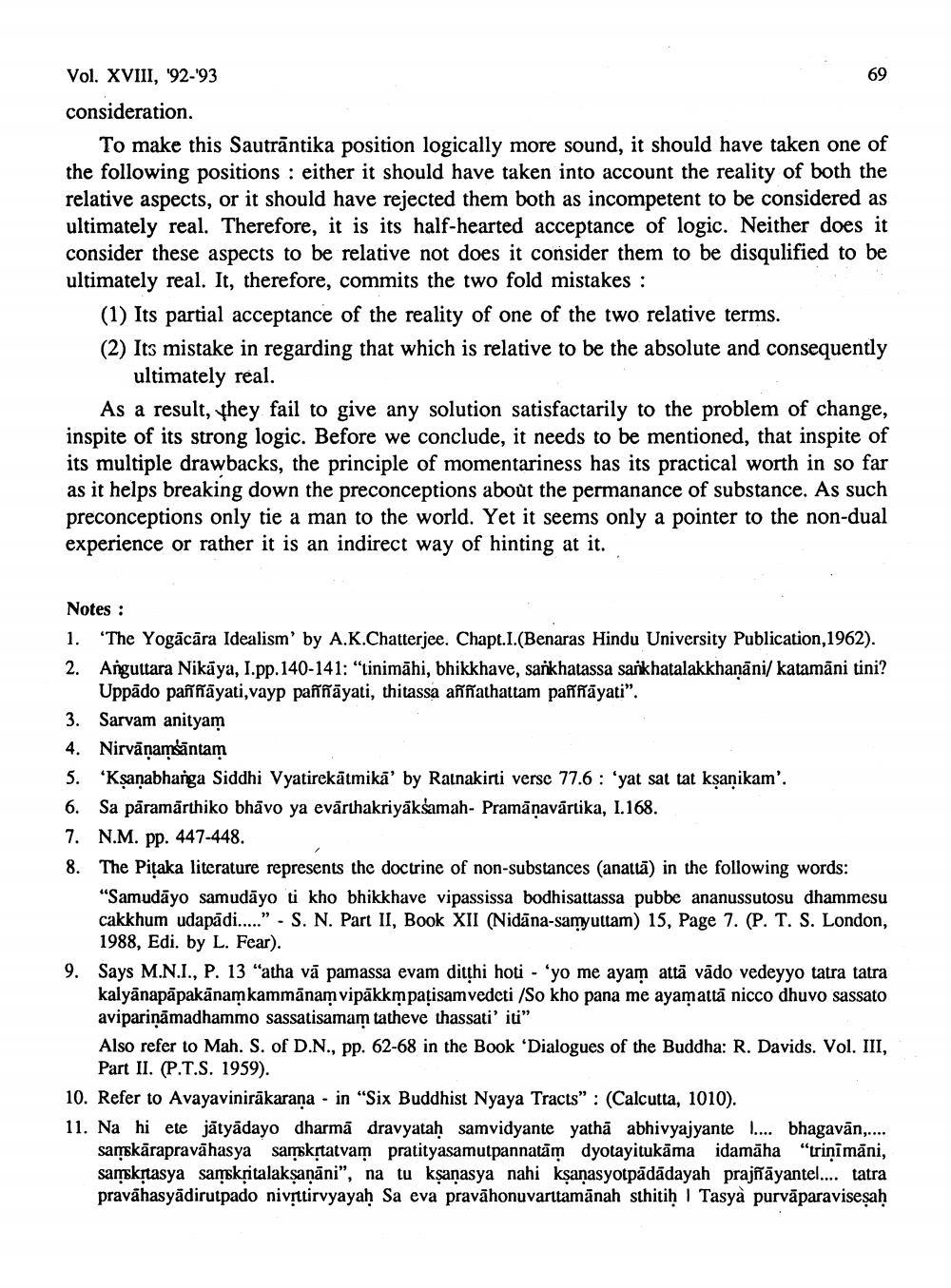________________
Vol. XVIII, '92-'93 consideration.
To make this Sautrāntika position logically more sound, it should have taken one of the following positions : either it should have taken into account the reality of both the relative aspects, or it should have rejected them both as incompetent to be considered as ultimately real. Therefore, it is its half-hearted acceptance of logic. Neither does it consider these aspects to be relative not does it consider them to be disqulified to be ultimately real. It, therefore, commits the two fold mistakes :
(1) Its partial acceptance of the reality of one of the two relative terms. (2) Its mistake in regarding that which is relative to be the absolute and consequently
ultimately real. As a result, they fail to give any solution satisfactarily to the problem of change, inspite of its strong logic. Before we conclude, it needs to be mentioned, that inspite of its multiple drawbacks, the principle of momentariness has its practical worth in so far as it helps breaking down the preconceptions about the permanance of substance. As such preconceptions only tie a man to the world. Yet it seems only a pointer to the non-dual experience or rather it is an indirect way of hinting at it.
Notes: 1. 'The Yogācāra Idealism' by A.K.Chatterjee. Chapt. I.(Benaras Hindu University Publication,1962). 2. Anguttara Nikāya, I.pp. 140-141: "linimāhi, bhikkhave, sarkhatassa sarkhatalakkhanāni/katamāni tini?
Uppādo paññāyati,vayp paññāyati, thitassa aññathattam paññāyati". 3. Sarvam anityam 4. Nirvānamšāntam 5. “Kşanabhanga Siddhi Vyatirekātmikā' by Ratnakirti verse 77.6 : 'yat sat tat ksanikam'. 6. Sa pāramārthiko bhāvo ya evārthakriyākšamah- Pramāņavārtika, 1.168. 7. N.M. pp. 447-448. 8. The Pitaka literature represents the doctrine of non-substances (anattā) in the following words:
"Samudāyo samudāyo ti kho bhikkhave vipassissa bodhisattassa pubbe ananussutosu dhammesu cakkhum udapādi...." - S. N. Part II, Book XII (Nidāna-samyuttam) 15, Page 7. (P. T. S. London,
1988, Edi. by L. Fear). 9. Says M.N.I., P. 13 "atha vā pamassa evam ditthi hoti - 'yo me ayam attā vādo vedeyyo tatra tatra
kalyānapāpakānamkammānam vipākkmpatisam vedeti /So kho pana me ayamattā nicco dhuvo sassato avipariņāmadhammo sassatisamam tatheve thassati' iti" Also refer to Mah. S. of D.N., pp. 62-68 in the Book 'Dialogues of the Buddha: R. Davids. Vol. III,
Part II. (P.T.S. 1959). 10. Refer to Avayavinirākarana - in "Six Buddhist Nyaya Tracts”: (Calcutta, 1010). 11. Na hi ete jātyādayo dharmā dravyataḥ samvidyante yathā abhivyajyante .... bhagavān,....
saņskārapravāhasya samskrtatvam pratityasamutpannatām dyotayitukāma idamāha "trinimāni, samskrtasya samskņitalaksaņāni", na tu kşanasya nahi kşanasyotpadadayah prajñāyantel.... tatra pravāhasyādirutpado nivrttirvyayah Sa eva pravāhonuvarttamānah sthitih | Tasya purvāparaviseṣaḥ




